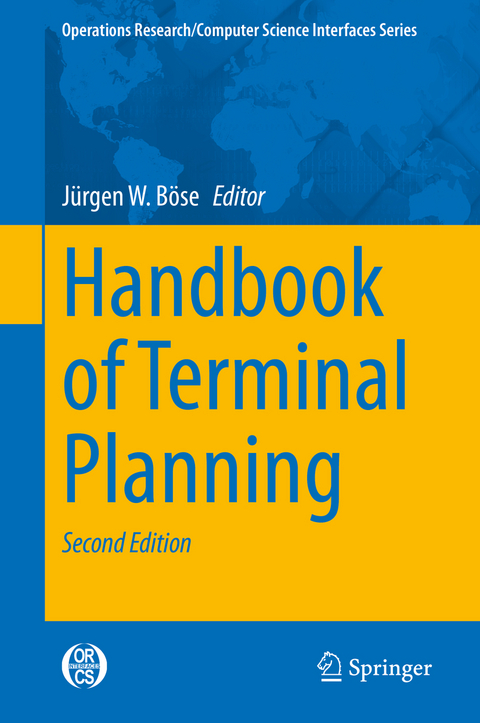
Handbook of Terminal Planning
Springer International Publishing (Verlag)
978-3-030-39989-4 (ISBN)
Seaport Container Terminals (SCT) operate as central nodes in worldwide hub-and-spoke networks, and link ocean-going vessels with smaller feeder vessels, as well as with inbound and outbound hinterland transportation systems using road, rail, or inland waterways. The volume of transcontinental container flows has gained enormously over the last five decades frequently leading to double-digit annual growth rates for the SCT.
The 2nd edition of the Handbook of Terminal Planning also deals with problems being induced by questions of terminal development on a long-term basis (strategic level). Facing present and upcoming challenges for SCT operation-such as more and more mega vessels, extremely high hinterland peaks, higher environmental standards, less public acceptance and the stronger competition between terminals serving the same hinterland-the focus of the book is on successful approaches and solutions primarily addressing the planning of terminal structures. Nevertheless, operational aspects are considered, as well as how they effectively contribute to problem solving on the strategic level.
Jurgen W. Boese is Professor of Logistics at Ostfalia University of Applied Sciences, Suderberg, Germany. Before that, he was Chief Engineer and Deputy Head of the Institute of Maritime Logistics, Hamburg University of Technology, and prior to that he was a Senior Consultant at HPC Hamburg Port Consulting GmbH. Prof. Dr. Boese has numerous publications on issues of maritime logistics and strategic terminal planning and made many presentations in this field at international conferences and workshops for practitioners and scientists.
Part I Introduction.- Chapter1. General Considerations on Terminal Planning, Innovations and Challenges.- Part II Basic Aspects.- Chapter2. Advanced Simulation Technology in Planning, Implementation and Operation of Container Terminals to Cope with the Varying Challenges Caused by the Shipping Industry (Holger Sch¨utt).- Chapter3. Modeling Techniques in Planning of Terminals: The Quantitative Approach Ensuring planning becomes reality - even in challenging times (Yvo A. Saanen).- Chapter4. Comparison of Fleet Size Determination Models for Horizontal Transportation of Shipping Containers using Automated Straddle Carriers (Bani Anvari, Apostolos Ziakopoulos, James Morley, Dimitris Pachakis,and Panayotis Angeloudis).- Chapter5. Automation and Electric Drives (Joan C. Rijsenbrij and Armin Wieschemann).- Chapter6. From Digitalization to Data-Driven Decision Making in Container Terminals (Leonard Heilig, Robert Stahlbock, and Stefan Voß).- Chapter7. Pavements for Container Terminals (David Schnabel).- Chapter8. Quay Wall Structures in Container Sea Ports and Influences on the Design (Jan Meyer).- Chapter9. The Value of a Cluster and Network Orientation for Container Terminals (Peter W. de Langen).- Chapter10. The Impact of Air Emissions Regulations on Terminals (Orestis Schinas).- Part III Seaside Access & Terminal Quayside.- Chapter11. Cost and Performance Evaluation Impacts of Container Ships on Seaport Container Terminals - An Update.- Chapter12. Ensuring Navigational Safety and Mitigate Maritime Traffic Risks while Designing Port Approaches and Ship Maneuvering Areas (Hans-Christoph Burmeister).- Chapter13. ITSS - The Integrated Terminal Ship System (Johannes March).- Chapter14. Planning Approach for Quayside Dimensioning of Automated Traffic Areas and Impact on Equipment Investment (Michael Ranau).- Chapter15. Raising Efficiency of Straddle Carrier Operations by Twin Container Handling (Ren´e Eisenberg, Thomas Koch, Marcel Petersen and Frank Wagner).- PartIV Planning Area.- Chapter16. Container Rehandling at Maritime Container Terminals: A Literature Update (Marco Caserta, Silvia Schwarze, and Stefan Voß).- Chapter17. State-of-the-art Yard Crane Scheduling and Stacking (Nils Kemme).- Chapter18. Comparison and Optimization of Automated Yard Crane Systems at Container Terminals (Ulf Speer and Kathrin Fischer)Chapter19. Optimal Stack Layout Configurations at Automated Container Terminals Using Queuing Network Models (Debjit Roy and Ren´e de Koster).- Part V Terminal Landside & Hinterland Access.- Chapter20. Port Feeder Barges as a Means to Improve Intra-port Container Logistics in Multi-terminal Ports (Ulrich Malchow).- Chapter21. Drayage Port - City Trucking (Jens Froese).- Chapter22. Port and Dry Port Life Cycles (Gordon Wilmsmeier and Jason Monios).- Chapter23. Flashlight on Intermodal Transport Innovation in European Seaport Hinterland (Thore Arendt).- Chapter24. Importance of Hinterland Transport Network Structures for SeaportContainer Terminals - An Update (Joachim R. Daduna and Robert Stahlbock).
| Erscheinungsdatum | 16.09.2020 |
|---|---|
| Reihe/Serie | Operations Research/Computer Science Interfaces Series |
| Zusatzinfo | XXV, 562 p. 172 illus., 126 illus. in color. |
| Verlagsort | Cham |
| Sprache | englisch |
| Maße | 155 x 235 mm |
| Gewicht | 1039 g |
| Themenwelt | Wirtschaft ► Allgemeines / Lexika |
| Wirtschaft ► Betriebswirtschaft / Management ► Unternehmensführung / Management | |
| Wirtschaft ► Volkswirtschaftslehre ► Wirtschaftspolitik | |
| Schlagworte | logistics • Quayside • Seaport Container Terminals • terminal design • Terminal Hinterland • Terminal Operation • Yard and Landside |
| ISBN-10 | 3-030-39989-3 / 3030399893 |
| ISBN-13 | 978-3-030-39989-4 / 9783030399894 |
| Zustand | Neuware |
| Informationen gemäß Produktsicherheitsverordnung (GPSR) | |
| Haben Sie eine Frage zum Produkt? |
aus dem Bereich


